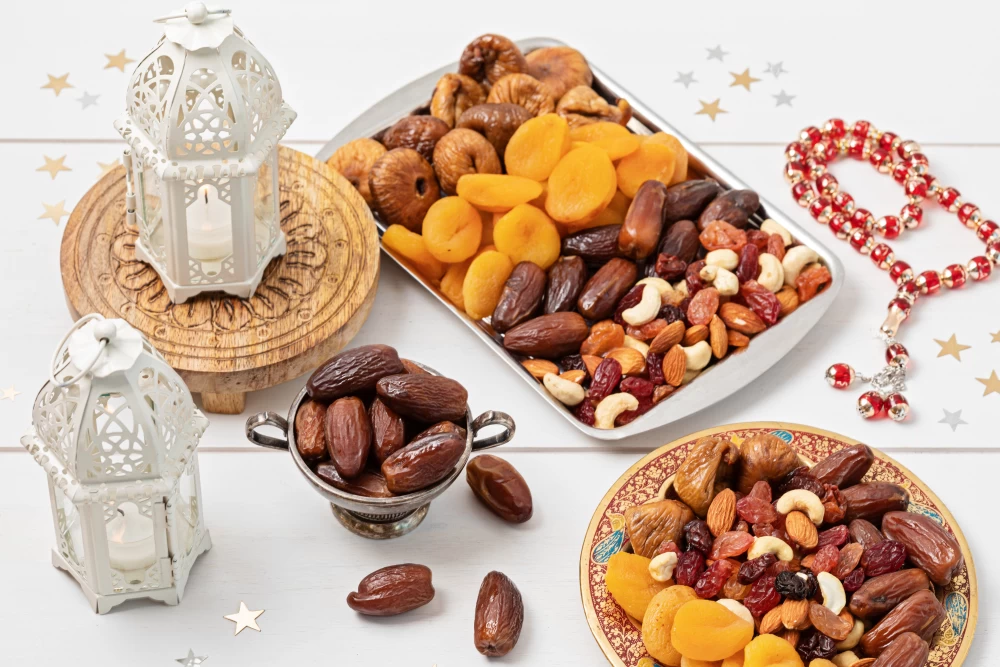
- 4th May 2023
Table of Contents
Fasting Patterns: Ramadan vs. Intermittent
Periods of fasting are alternated with times of normal eating as part of the intermittent fasting diet. The Muslim holy month of Ramadan also includes fasting at irregular intervals. During this month, Muslims around the world abstain from eating and drinking from sunrise to sunset. Those who are already used to intermittent fasting for other reasons may find it easy to incorporate it into their Ramadan routine. However, for those who are unfamiliar with both concepts, striking a balance between religious obligations and dietary needs can be challenging. Fasting for shorter durations in the days leading up to Ramadan or eating less during non-fasting hours can help ease one into the practise. When you're not fasting, make sure you drink plenty of water and eat nutritious meals. Overall, a more satisfying and holistic way of life can be achieved by combining religious practises with healthy dietary habits. It is possible to observe Ramadan while following the principles of intermittent fasting with the right preparation and guidance.
Fasting Improves Your Health
The practise of fasting is widespread across religious and cultural boundaries, and for good reason: it's good for you. Intermittent fasting, in which one alternates periods of eating and fasting, is rapidly gaining in popularity. There is evidence that fasting in this manner is beneficial for insulin sensitivity, inflammation, weight loss, and cardiovascular health. One religious tradition that calls for prolonged fasting is Ramadan. For 30 days, Muslim men and women will refrain from eating or drinking anything, including water, during daylight hours. Fasting during Ramadan has been linked to lower levels of oxidative stress and may have neuroprotective effects, according to research. The spiritual and physical health benefits of including fasting in religious practises like Ramadan are well-documented. Fasting and other major dietary changes should only be attempted after discussing the risks and benefits with a qualified medical professional.
Making Ready for Ramadan

Muslims around the world observe a daily fast from dawn until dusk during the month of Ramadan, a holy time in the Islamic calendar. It's a chance to work on self-discipline and improve your physical health through intermittent fasting, and it's also a time for spiritual reflection and devotion. The health benefits of intermittent fasting, such as weight loss, a faster metabolism, and more energy, have led to the practice's meteoric rise in popularity in recent years. Physical and mental preparation is crucial for Muslims who are new to intermittent fasting or who want to incorporate it into their religious practises during Ramadan. One method is to prepare for Ramadan by eating less and fasting for shorter periods of time in the weeks leading up to the holy month. In order to avoid becoming dehydrated during the long days of Ramadan, it is essential to drink plenty of water even when you are not fasting. People who are taking prescription drugs or have ongoing medical issues should talk to their doctors before making major lifestyle changes like cutting out certain foods or fasting for an extended period of time. With the right mindset and support, incorporating intermittent fasting into religious practises during Ramadan can be a profoundly rewarding and life-changing experience.
Bringing Together Ramadan and Periodic Fasting
Combining Ramadan with intermittent fasting can be difficult but worthwhile. Fasting for 16 hours at a time and eating for only 8 hours is a common pattern in intermittent fasting. During the month of Ramadan, Muslims around the world abstain from eating and drinking from dawn until dusk. Some people recommend easing into Ramadan-style intermittent fasting by starting with shorter fasts and working up to longer ones. Keep your energy up during the day by drinking plenty of water even when you're not fasting. You can give your body the fuel it needs to get through the next fasting period by including healthy foods like fruits, vegetables, whole grains, and lean proteins in your regular meal plans. Overall, there can be physical and spiritual benefits to combining intermittent fasting with religious practises like Ramadan. By cultivating a sense of gratitude and appreciation for one's health through mindful eating and a focus on nourishing the body during meal times, one can also show respect for one's religious beliefs.
Taking in the Suhoor and Iftar Meals
In order to properly observe the religious practise of fasting during Ramadan, eating at suhoor and iftar is required. The predawn meal, or suhoor, is eaten by Muslims around the world before they begin fasting for the day. Eating a healthy, well-balanced meal that can keep you going all day is highly recommended. Whole grains, fruits, vegetables, and lean proteins are great options for suhoor because they are high in complex carbohydrates, fibre, and protein. The fast is broken with the evening iftar meal. Dates are traditionally eaten to break the fast, followed by a light snack or soup, and then a full meal. Fruits and vegetables, which are rich in vitamins and minerals, and lean meats, which are low in saturated fat, should make up the bulk of the meal. Maintaining adequate hydration during the fasting period necessitates taking in a large amount of fluids between the iftar and suhoor meals. Caffeine has diuretic properties, so avoiding tea and coffee can help you stay hydrated. By incorporating these eating habits into one's fasting routine, one can ensure that their body receives sufficient nutrients during this holy month and have more energy throughout the day.
Self-Care Tips for the Holy Month of Ramadan
During the Islamic holy month of Ramadan, Muslims around the world observe a daily fast from dawn until dusk. This can be difficult and draining for many people, especially if they have daytime obligations such as work or caring for children. To get the most out of this holy time, take care of yourself by drinking plenty of water and eating healthy foods during the allotted eating times. If you want to help your body deal with the physical demands of fasting, it's important to get plenty of sleep every night and not overdo it during the day. Fresh fruits and vegetables, lean proteins like chicken or fish, and whole grains like brown rice and quinoa are all great examples of wholesome foods that are high in nutrients but low in calories. Finally, keep in mind that Ramadan isn't just about not eating during the day; it's also a time for introspection and spiritual renewal. Make the most of it by devoting some time every day to spiritual practises like meditation, prayer, or reading religious texts. You can come out of Ramadan feeling renewed and refreshed if you take good care of yourself physically and spiritually.
Incorporating Both Practices, Ultimately
Combining the health benefits of intermittent fasting with those of Ramadan can help you feel and look better. In addition to facilitating weight loss, intermittent fasting has been shown to improve glucose homeostasis, energy levels, and mental acuity. However, during the month of Ramadan, practising Muslims refrain from eating and drinking during daylight hours as a form of self-discipline. Following the rules of Ramadan while maintaining your regular intermittent fasting routine is one way to combine the two practises. This involves eating something nutritious, like dates or water, to break your fast, followed by a healthy dinner. Keep drinking water throughout the day and don't stuff yourself silly at iftar. Outside of religious contexts, fasting during Ramadan can serve as a reminder to make mindful food choices when breaking fasts. Fasting can have long-term positive effects on health and well-being if it is combined with the adoption of healthy lifestyle habits. You may find greater physical health and spiritual contentment through the integration of these two practises.
